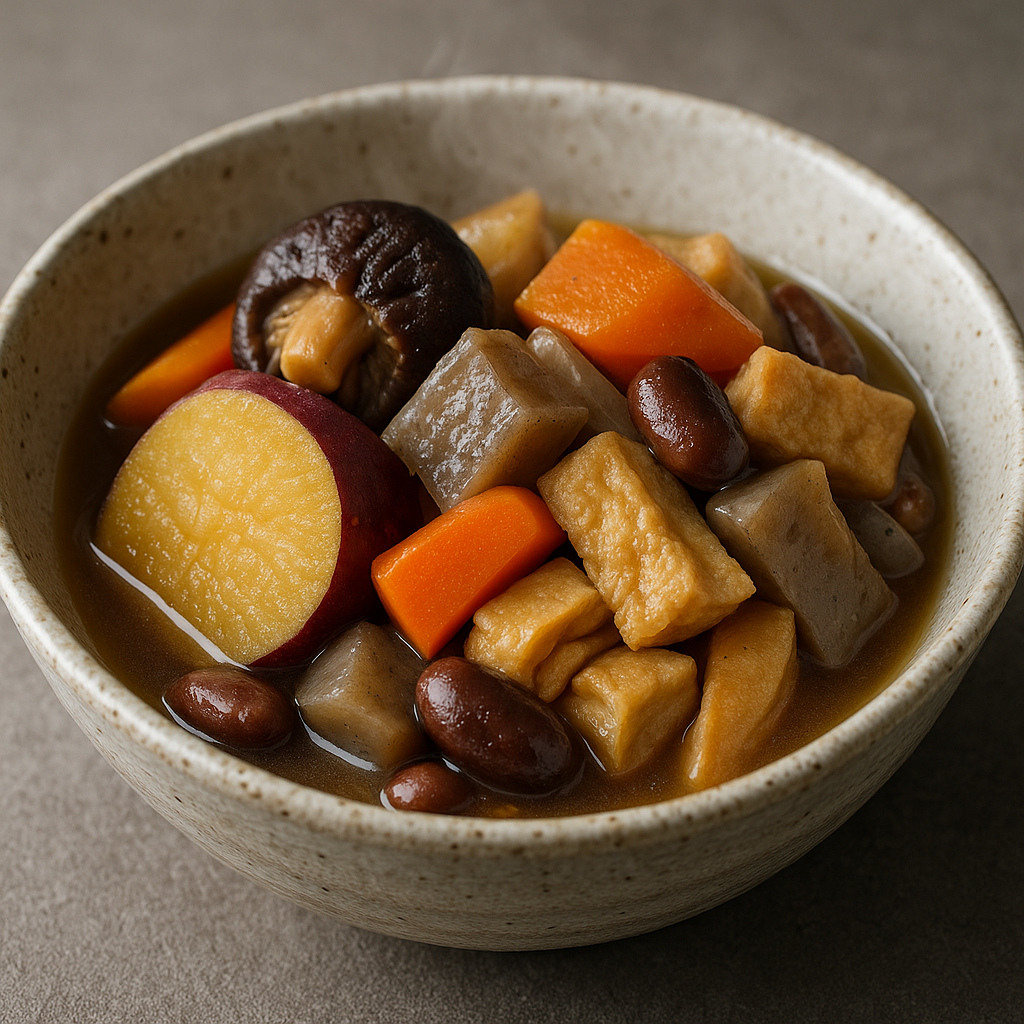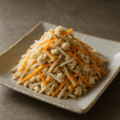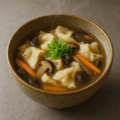ねりこみの特徴
津軽の慶弔でも供される、甘口の“くず寄せ風”煮物
「ねりこみ」は津軽地方で親しまれる郷土料理。季節の野菜やこんにゃくを出汁(または水)でたっぷり煮て、砂糖と塩(少量の醤油)で味つけし、片栗粉でとろりとまとめます。冷めにくく、おもてなしにも重宝されます。
片栗粉で“とろみ”をつけて一体感
具材の角を残した切り方で食感を出し、仕上げに水溶き片栗粉でつややかなとろみをつけるのが基本。口あたりがよく、甘塩っぱさがご飯や茶席に合います。
季節と晴れ日に応じて具が変わる
初夏はえんどう豆、秋は里芋、冬はいんげん豆など四季の素材で変化。慶事には栗やいくらを加えて華やかに仕立てることもあります。
ねりこみのレシピ
材料(4人分)
- さつまいも … 300g(大きめの乱切り・水にさらす)
- にんじん … 80g(小さめの乱切り)
- こんにゃく … 150g(短冊・下ゆで)
- 油揚げ … 1枚(一口大の三角)
- 生しいたけ … 3枚(食べやすく)
- 出汁または水 … 500〜600ml(具がひたひた)
調味
- 砂糖(上白糖またはざらめ) … 40〜60g
- 塩 … 小さじ1/2弱(味を見て)
- 醤油 … 小さじ1(風味づけ・任意)
- 片栗粉 … 大さじ2(同量の水で溶く)
作り方
- 下ごしらえ:さつまいもは水にさらしてでんぷんを落とす。こんにゃくは下ゆでして臭みを抜く。
- 煮る:鍋ににんじん→出汁(または水)を注ぎ、続けてさつまいも・油揚げ・こんにゃく・しいたけを入れる。具がひたる量を目安に。
- 味つけ:砂糖を加えてやわらかくなるまで煮る。塩で全体を調え、仕上げに醤油少々で輪郭をつける。
- とろみ:一度火を弱め、水溶き片栗粉を回し入れて静かに加熱。つやが出てふつふつしたら火を止める。彩りの豆を加えてひと混ぜ。
- 仕上げ:数分休ませて味を含ませる。温かくても、少し落ち着かせても美味。
シェフのワンポイントアドバイス
甘みは砂糖を先に含ませるのがコツ。片栗粉は沸騰直前〜弱火で入れ、混ぜすぎないと透明感が残ります。晴れの日は栗の甘露煮や少量のいくらで華やかに。
栄養価(1人分の目安)
- エネルギー:約150〜230 kcal
- たんぱく質:3〜6 g
- 脂質:3〜7 g
- 炭水化物:25〜40 g
根菜由来の炭水化物に、油揚げで適度なたんぱく質と脂質。砂糖量で甘さとカロリーを調整できます。
歴史
托鉢と精進の知恵から生まれた“ねりこみ”
弘前禅林の僧が托鉢で授かった野菜を寄せ集めて作る“くず寄せ”が始まりとも伝わり、冠婚葬祭のおもてなしとして受け継がれてきました。名称は「練り込む」製法に由来する説もあります。
津軽一円に広がる家庭の味
砂糖を多めに使い、とろみで冷めにくく仕上げるのが津軽風。季節の豆や芋を主役に、地域・家庭で具材や甘さが変わります。
English Version
Features of “Nerikomi”
A sweet, kuzuyose-style stew served at ceremonies in Tsugaru
Nerikomi is a beloved Tsugaru home dish. Seasonal vegetables and konnyaku are simmered in dashi (or water), seasoned gently with sugar, salt, and a touch of soy, then finished with potato starch for a smooth glaze. It stays warm and is handy for hospitality.
Unified by a silky potato-starch gloss
Cut the ingredients into facets to keep texture, then thicken with a slurry of potato starch at the end. The soft, sweet–savory profile pairs well with rice and tea-service fare.
Ingredients vary by season and occasion
Peas in early summer, taro in autumn, white beans in winter—additions shift with the seasons. For festive tables, chestnuts in syrup or a touch of salmon roe lend a celebratory look.
Recipe
Ingredients (serves 4)
- Sweet potato … 300 g (large chunks; rinse and soak)
- Carrot … 80 g (small chunks)
- Konnyaku … 150 g (batons; parboiled)
- Abura-age (fried tofu) … 1 sheet (triangles)
- Shiitake mushrooms … 3 caps (bite-size)
- Dashi or water … 500–600 ml (just to cover)
Seasoning
- Sugar (white or coarse) … 40–60 g
- Salt … a scant 1/2 tsp (to taste)
- Soy sauce … 1 tsp (optional, for definition)
- Potato starch … 2 tbsp (mixed with the same amount of water)
Instructions
- Prep: Soak sweet potato to remove surface starch. Parboil konnyaku to deodorize.
- Simmer: In a pot add carrot, then pour in dashi (or water). Add sweet potato, abura-age, konnyaku, and shiitake. Liquid should just cover the ingredients.
- Season: Add sugar and simmer until tender. Adjust with salt; finish with a little soy sauce to sharpen the flavor.
- Thicken: Lower the heat and stir in the potato-starch slurry. Warm gently until glossy bubbles appear, then turn off the heat. Fold in green peas or edamame for color if you like.
- Rest: Let stand a few minutes to absorb flavor. Delicious hot or slightly cooled.
Chef’s Tip
Add sugar first so it penetrates. Stir in starch on low to just below a boil to keep clarity—avoid overmixing. For celebratory service, top with syruped chestnuts or a little ikura.
Nutritional Value (per serving, approx.)
- Calories: 150–230 kcal
- Protein: 3–6 g
- Fat: 3–7 g
- Carbohydrates: 25–40 g
Roots provide carbohydrates; abura-age adds moderate protein and fat. Adjust sweetness and calories by varying the sugar.
History
Born from alms and temple vegetarian cookery
One origin story traces nerikomi to monks in Hirosaki gathering alms vegetables into a kuzuyose-style stew served at ceremonial meals. The name is also said to come from the “kneading-in” technique.
A household taste across Tsugaru
Using a bit more sugar and a starch finish that keeps heat is typical of Tsugaru style. Beans or tubers often take the lead, with ingredients and sweetness varying by district and household.



何でも質問してください!